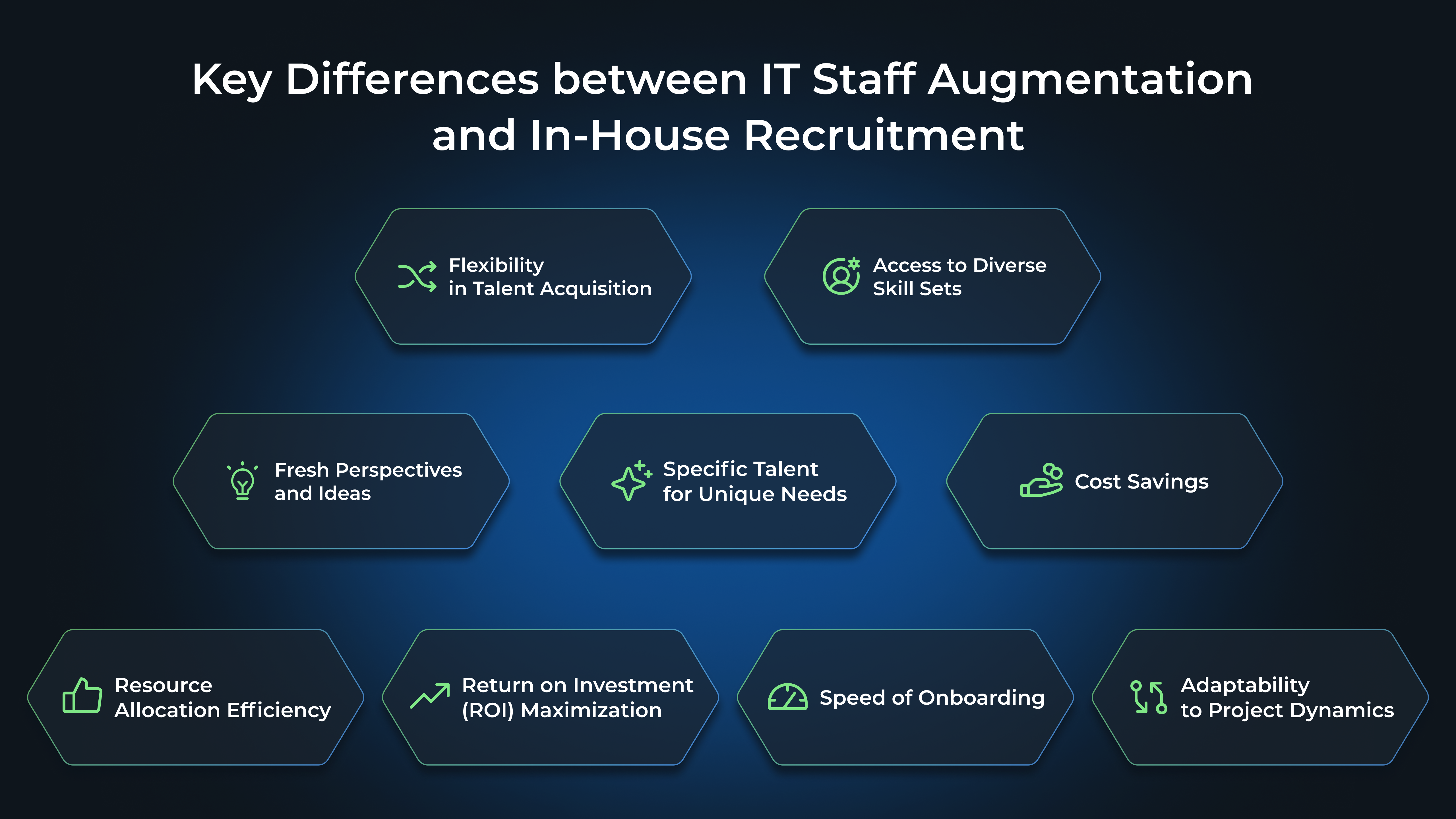We at WeSoftYou understand that making the right decision when it comes to hiring IT professionals is crucial for the success of your business. With the ever-growing importance of technology in today’s world, choosing between IT staff augmentation and in-house recruitment can be a challenging task. In this article, we will explore the two approaches, highlight their benefits and drawbacks, compare them based on different factors, and provide you with factors to consider when making this decision. So, let’s dive in!
What Is IT Staff Augmentation?
IT staff augmentation allows you to scale your team quickly and efficiently without the need to go through the lengthy and often costly process of recruiting and onboarding full-time employees. It provides you with the flexibility to bring in specialized talent for short-term projects or to deal with peak workloads.
When you engage in IT staff augmentation, you gain access to a vast network of skilled professionals who can contribute their expertise to your team. These professionals are typically experienced in various technologies and domains, allowing them to bring fresh perspectives and ideas to your projects. Whether you need a software developer, a cybersecurity expert, or a data analyst, IT staff augmentation can provide you with the right talent to meet your specific needs.
Furthermore, IT staff augmentation offers cost savings compared to hiring full-time employees. With staff augmentation, you only pay for the specific skills and time required for your project. This means you can avoid the overhead costs associated with full-time employment, such as benefits, office space, and equipment. By leveraging IT staff augmentation, you can allocate your resources more efficiently and maximize your return on investment.
Benefits of IT Staff Augmentation
-
Access to Global Talent Pool: Break through geographical constraints and collaborate with specialized IT professionals worldwide, bringing diverse expertise and perspectives to your projects.
-
Cost Savings: Pay only for the specific skills and time required, avoiding the overhead costs associated with full-time employment. Ideal for businesses with budget constraints or fluctuating project demands.
-
Financial Efficiency for SMBs: Particularly advantageous for small and medium-sized businesses, IT staff augmentation allows access to top talent while staying within budgetary limits.
-
Flexibility in Team Scaling: Adapt quickly to project needs by scaling your team up or down without the long-term commitments of full-time hires. Maintain agility in response to changing business demands.
Potential Drawbacks of IT Staff Augmentation
-
Integration Challenges: Incorporating external team members into your existing staff may pose challenges in communication and collaboration. Establishing clear communication channels, setting expectations, and fostering a collaborative environment are crucial for seamless integration.
-
Contractual Complexity: Managing various contractual agreements with different professionals requires careful coordination. Ensuring consistency in quality across diverse team members demands vigilant oversight, clear guidelines, and regular feedback to maintain project standards.
Despite these potential challenges, with proper planning, communication, and coordination, IT staff augmentation can be a valuable strategy to enhance your team’s capabilities and achieve your business goals. By leveraging external expertise and resources, you can tackle complex projects, meet tight deadlines, and drive innovation within your organization.
What Is In-House Recruitment?
With in-house recruitment, you have the opportunity to build a dedicated team that aligns with your company’s culture and long-term goals. These team members become fully immersed in your business operations and have a deeper understanding of your specific needs and objectives.
When you hire full-time employees, you are essentially investing in the growth and success of your organization. These individuals become an integral part of your company, contributing their skills and expertise to drive innovation and achieve your business objectives.
Advantages of In-House Recruitment
-
Commitment and Loyalty: Full-time employees demonstrate a high level of commitment and loyalty, fostering a sense of dedication to the success of the business. This commitment can contribute to long-term stability and success.
-
Continuity and Stability: Full-time hires provide continuity, as they become intimately familiar with your systems and processes over time. This deep understanding leads to increased efficiency and productivity, enhancing overall operational stability.
-
Collaboration and Synergy: A dedicated team of full-time employees facilitates better collaboration and synergy. Their close working relationships enable them to leverage collective knowledge and skills, making them more effective in tackling complex projects and overcoming challenges.
-
Efficiency and Productivity: In-depth knowledge of systems and processes, coupled with a long-term commitment, results in increased efficiency and productivity. Full-time employees are invested in the organization’s success, contributing positively to its growth.
-
Strong Company Culture: In-house recruitment allows for the development of a strong company culture. Long-term employees build relationships, fostering a sense of belonging and contributing to a positive work environment. This, in turn, enhances overall employee satisfaction.
Disadvantages of In-House Recruitment
IT Staff Augmentation vs. In-House Recruitment: Key Differences

IT Staff Augmentation vs. In-House Recruitment: Key Differences
In the dynamic landscape of talent acquisition, the choice between IT staff augmentation and in-house recruitment plays a pivotal role in shaping your workforce strategy. In-house recruitment involves the traditional, often time-consuming process of recruiting and onboarding full-time employees, providing stability but limiting flexibility. On the other hand, IT staff augmentation introduces a more agile approach, allowing you to swiftly adapt to project needs by bringing in specialized talent for short-term endeavors or to handle peak workloads.
When opting for IT staff augmentation, you open the doors to a vast network of skilled professionals ready to contribute their expertise to your team. These individuals typically boast diverse experiences across various technologies and domains, injecting fresh perspectives and innovative ideas into your projects. Whether your requirement is for a seasoned software developer, a cybersecurity expert, or a proficient data analyst, IT staff augmentation ensures access to the right talent tailored to meet your specific needs.
Moreover, beyond the infusion of specialized skills, IT staff augmentation offers a strategic advantage in terms of cost savings. Unlike the traditional model of hiring full-time employees, where overhead costs such as benefits, office space, and equipment are inherent, staff augmentation allows you to pay only for the specific skills and time required for your project. This cost-efficiency not only enhances resource allocation but also positions your organization to maximize return on investment, a crucial consideration in today’s competitive business landscape.
In essence, the decision between IT staff augmentation and in-house recruitment extends beyond mere operational preferences; it shapes the adaptability, efficiency, and strategic positioning of your workforce. While in-house recruitment provides stability, IT staff augmentation empowers you with the flexibility to navigate the evolving demands of the modern business environment, ensuring a more dynamic and responsive approach to talent acquisition.
Benefits of IT Staff Augmentation
-
Access to Global Talent Pool: Break through geographical constraints and collaborate with specialized IT professionals worldwide, bringing diverse expertise and perspectives to your projects.
-
Cost Savings: Pay only for the specific skills and time required, avoiding the overhead costs associated with full-time employment. Ideal for businesses with budget constraints or fluctuating project demands.
-
Financial Efficiency for SMBs: Particularly advantageous for small and medium-sized businesses, IT staff augmentation allows access to top talent while staying within budgetary limits.
-
Flexibility in Team Scaling: Adapt quickly to project needs by scaling your team up or down without the long-term commitments of full-time hires. Maintain agility in response to changing business demands.
Potential Drawbacks of IT Staff Augmentation
-
Integration Challenges: Incorporating external team members into your existing staff may pose challenges in communication and collaboration. Establishing clear communication channels, setting expectations, and fostering a collaborative environment are crucial for seamless integration.
-
Contractual Complexity: Managing various contractual agreements with different professionals requires careful coordination. Ensuring consistency in quality across diverse team members demands vigilant oversight, clear guidelines, and regular feedback to maintain project standards.
Despite these potential challenges, with proper planning, communication, and coordination, IT staff augmentation can be a valuable strategy to enhance your team’s capabilities and achieve your business goals. By leveraging external expertise and resources, you can tackle complex projects, meet tight deadlines, and drive innovation within your organization.
Exploring In-House Recruitment
Now let’s turn our attention to in-house recruitment. In-house recruitment involves bringing IT professionals onboard as permanent employees. These professionals become part of your organization and work exclusively for your company on a long-term basis.
When it comes to in-house recruitment, there are various aspects to consider. Let’s delve deeper into what in-house recruitment means and explore the advantages and possible disadvantages associated with this approach.
What Is In-house recruitment?
With in-house recruitment, you have the opportunity to build a dedicated team that aligns with your company’s culture and long-term goals. These team members become fully immersed in your business operations and have a deeper understanding of your specific needs and objectives.
When you hire full-time employees, you are essentially investing in the growth and success of your organization. These individuals become an integral part of your company, contributing their skills and expertise to drive innovation and achieve your business objectives.
Advantages of In-house recruitment
-
Commitment and Loyalty: Full-time employees demonstrate a high level of commitment and loyalty, fostering a sense of dedication to the success of the business. This commitment can contribute to long-term stability and success.
-
Continuity and Stability: Full-time hires provide continuity, as they become intimately familiar with your systems and processes over time. This deep understanding leads to increased efficiency and productivity, enhancing overall operational stability.
-
Collaboration and Synergy: A dedicated team of full-time employees facilitates better collaboration and synergy. Their close working relationships enable them to leverage collective knowledge and skills, making them more effective in tackling complex projects and overcoming challenges.
-
Efficiency and Productivity: In-depth knowledge of systems and processes, coupled with a long-term commitment, results in increased efficiency and productivity. Full-time employees are invested in the organization’s success, contributing positively to its growth.
-
Strong Company Culture: In-house recruitment allows for the development of a strong company culture. Long-term employees build relationships, fostering a sense of belonging and contributing to a positive work environment. This, in turn, enhances overall employee satisfaction.
Disadvantages of In-house recruitment
Factors to Consider When Choosing IT Staff Augmentation vs. In-House Recruitment
Now that you have a clear understanding of the two approaches and their differences, it’s important to consider certain factors when making a decision. Here are a few key factors to consider:
Assess Your Business Needs
Evaluate your business needs and project requirements. Determine whether you need specialized expertise for a specific project or long-term support and continuity.
When assessing your business needs, it’s crucial to consider the complexity of your projects. Some projects may require specialized skills and knowledge that can only be provided by IT staff augmentation. On the other hand, if your projects are relatively straightforward and don’t require extensive expertise, in-house recruitment might be a more cost-effective option.
Additionally, consider the scalability of your projects. If you anticipate fluctuating workloads or have short-term projects with varying demands, IT staff augmentation can provide the flexibility to scale your team up or down as needed. However, if your projects are long-term and require consistent support, in-house recruitment can ensure continuity and stability.
Evaluate Your Budget
Consider your budget and financial resources. Evaluate the costs associated with both IT staff augmentation and in-house recruitment and determine what aligns with your financial capabilities.
When evaluating your budget, it’s important to take into account not only the direct costs but also the indirect costs associated with each approach. IT staff augmentation may involve higher hourly rates or project-based fees, but it eliminates the need for additional expenses such as benefits, training, and equipment. On the other hand, in-house recruitment may require a larger upfront investment in terms of salaries and benefits, but it provides long-term cost savings if you have ongoing projects that require consistent support.
Furthermore, consider the potential return on investment (ROI) for each approach. IT staff augmentation can provide immediate access to specialized skills and knowledge, which can accelerate project timelines and deliver faster results. In-house recruitment, on the other hand, allows for greater control and ownership over the resources, which can lead to higher productivity and efficiency in the long run.
Consider Your Project Timeline
Take into account the timeline of your projects. If you have short-term projects with fluctuating workloads, IT staff augmentation might be the better option. However, if you have long-term, ongoing projects that require consistent support, in-house recruitment might be more suitable.
When considering your project timeline, it’s important to assess the urgency and duration of your projects. IT staff augmentation can provide immediate access to a pool of skilled professionals who can quickly ramp up and contribute to your projects. This can be particularly beneficial for time-sensitive projects or when you need to meet tight deadlines.
On the other hand, in-house recruitment allows for greater control over the resources and fosters a sense of ownership and commitment. If you have long-term projects that require continuous support and collaboration, having dedicated full-time employees can ensure consistency and enable better knowledge transfer within your organization.
Ultimately, the decision between IT staff augmentation and in-house recruitment depends on a variety of factors unique to your business. By carefully assessing your business needs, evaluating your budget, and considering your project timeline, you can make an informed decision that aligns with your goals and objectives.
How to Choose for Your Business?
Choosing between IT staff augmentation and in-house recruitment is a decision that depends on various factors specific to your business. Remember, it’s not a one-size-fits-all approach. Both approaches have their own benefits and considerations. Here are a few scenarios to help guide your decision:
When to Choose IT Staff Augmentation?
IT staff augmentation might be the best choice for your business if you need specialized expertise for short-term projects, want access to a pool of diverse talent, or require scalability to handle fluctuating workloads. It can provide you with the flexibility and cost-effectiveness you need.
For example, let’s say your business is in the process of developing a new mobile application. You have a specific timeline to meet, and you need developers with expertise in both iOS and Android platforms. By opting for IT staff augmentation, you can quickly bring in developers who specialize in these areas and have them work on your project for the duration needed. This allows you to tap into their specific skills without the long-term commitment of hiring full-time employees.
Additionally, IT staff augmentation can be beneficial if your business experiences seasonal fluctuations in workload. For instance, if you run an e-commerce website and expect a surge in orders during the holiday season, you can augment your existing IT team with temporary staff to handle the increased demand. Once the busy period is over, you can scale back without the need to lay off full-time employees.
When to Choose In-House Recruitment?
In-house recruitment might be the best choice when you have long-term projects that require consistent support, value loyalty and commitment, or need greater control over your team members. It allows you to build a dedicated team that aligns with your company’s culture and long-term goals.
For example, if your business is in the process of developing a complex software product that requires ongoing maintenance and updates, having a dedicated team of full-time employees can provide the stability and continuity needed for such projects. These employees can become deeply familiar with your product and its intricacies, allowing for efficient problem-solving and seamless collaboration.
In addition, in-house recruitment can be advantageous if your business places a high value on loyalty and commitment. By hiring employees on a permanent basis, you can foster a sense of belonging and loyalty within your team, which can lead to increased productivity and employee satisfaction.
Balancing Both Approaches in Your Business
As a software development company with a proven track record, WeSoftYou recommends considering a hybrid approach that combines IT staff augmentation and in-house recruitment. This allows you to leverage the benefits of both approaches and create a dynamic and flexible team structure that suits your specific needs.
For instance, you can have a core team of full-time employees who handle the day-to-day operations and provide stability, while also supplementing them with specialized IT staff augmentation for short-term projects or to address specific skill gaps. This hybrid approach offers the best of both worlds, providing you with a dedicated team that aligns with your company’s culture and long-term goals, while also allowing you to tap into external expertise as needed.
In conclusion, choosing between IT staff augmentation and in-house recruitment is a decision that requires careful consideration of various factors. By assessing your business needs, evaluating your budget, and considering project timelines, you can make an informed decision that aligns with your goals. Whether you choose IT staff augmentation, in-house recruitment, or a hybrid approach, WeSoftYou can provide you with the expertise and support you need in software development. Contact us for a free consultation or project estimation today!
Conclusion
When it comes to deciding between IT staff augmentation and in-house recruitment, it’s important to consider the specific needs and goals of your business. Assessing factors such as project duration, required skill sets, budget constraints, and long-term plans can help you determine the most suitable approach.
Furthermore, it’s essential to evaluate the potential risks and benefits associated with each approach. While IT staff augmentation offers flexibility and cost savings, in-house recruitment provides stability and deeper integration within your organization. By carefully weighing these factors, you can make an informed decision that aligns with your business objectives.
At WeSoftYou, we understand that every business is unique, and there is no one-size-fits-all solution. Our team of experienced professionals can guide you through the decision-making process, offering expert advice and tailored solutions. Whether you need short-term support for a specific project or are looking to build a dedicated IT team, we are here to help you navigate the complexities of IT staffing.
FAQ
The main difference lies in the duration and commitment of the professionals. IT staff augmentation involves hiring external IT professionals on a temporary basis, while in-house recruitment involves bringing IT professionals onboard as permanent employees.
When you opt for IT staff augmentation, you have the flexibility to bring in experts for specific projects or periods of high demand. This allows you to scale your team up or down as needed, without the long-term commitment of full-time employment. On the other hand, in-house recruitment provides you with a dedicated team that is fully integrated into your organization, offering continuity and long-term support.
IT staff augmentation is often more cost-effective as it allows you to pay for specific skills and time without the overhead costs associated with full-time employment. When you hire IT professionals on a temporary basis, you can avoid expenses such as benefits, office space, and equipment that come with full-time employees.
Additionally, IT staff augmentation enables you to access a global talent pool, which can be more cost-effective compared to hiring locally. By leveraging the expertise of professionals from different regions, you can benefit from competitive pricing and diverse skill sets.
Absolutely! Many businesses find success in implementing a hybrid approach that combines both IT staff augmentation and in-house recruitment. This allows you to leverage the benefits of both approaches and create a dynamic and flexible team structure.
By combining IT staff augmentation and in-house recruitment, you can have a core team of permanent employees who provide stability and continuity, while also having the flexibility to bring in specialized experts for specific projects or to handle peak workloads. This hybrid model enables you to optimize your resources, adapt to changing business needs, and achieve the best of both worlds.
Contact us now for a free consultation or project estimation. We at WeSoftYou are here to help you make the right decision for your business!





















